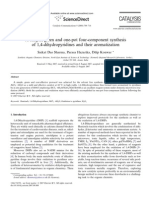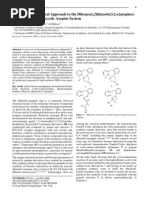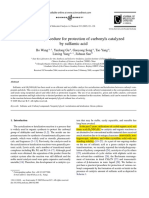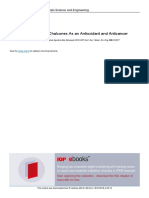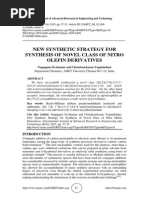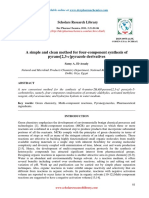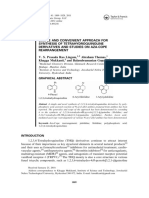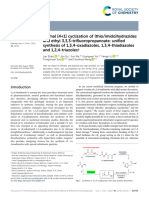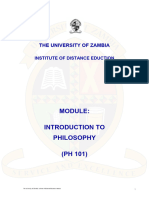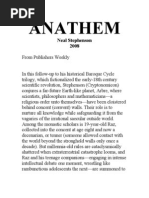A Wittig-olefination-Claisen-rearrangement Approach To The 3-Methylquinoline-4-Carbaldehyde Synthesis
A Wittig-olefination-Claisen-rearrangement Approach To The 3-Methylquinoline-4-Carbaldehyde Synthesis
Uploaded by
Muhammad Mirza HardiansyahCopyright:
Available Formats
A Wittig-olefination-Claisen-rearrangement Approach To The 3-Methylquinoline-4-Carbaldehyde Synthesis
A Wittig-olefination-Claisen-rearrangement Approach To The 3-Methylquinoline-4-Carbaldehyde Synthesis
Uploaded by
Muhammad Mirza HardiansyahOriginal Title
Copyright
Available Formats
Share this document
Did you find this document useful?
Is this content inappropriate?
Copyright:
Available Formats
A Wittig-olefination-Claisen-rearrangement Approach To The 3-Methylquinoline-4-Carbaldehyde Synthesis
A Wittig-olefination-Claisen-rearrangement Approach To The 3-Methylquinoline-4-Carbaldehyde Synthesis
Uploaded by
Muhammad Mirza HardiansyahCopyright:
Available Formats
A Wittig-olefinationClaisen-rearrangement
approach to the 3-methylquinoline4-carbaldehyde synthesis
Mukund G. Kulkarni*, Mayur P. Desai, Deekshaputra R. Birhade,
Yunus B. Shaikh, Ajit N. Dhatrak and Ramesh Gannimani
Full Research Paper
Address:
Department of Chemistry, University of Pune, Ganeshkhind, Pune
411007, India; Fax: +91 (020) 25691728
Open Access
Beilstein J. Org. Chem. 2012, 8, 17251729.
doi:10.3762/bjoc.8.197
Email:
Mukund G. Kulkarni* - mgkulkarni@chem.unipune.ac.in
Received: 13 May 2012
Accepted: 06 September 2012
Published: 11 October 2012
* Corresponding author
Associate Editor: J. Aube
Keywords:
acetal; Claisen rearrangement; oxidative cleavage; ring-closure; Wittig
olefination
2012 Kulkarni et al; licensee Beilstein-Institut.
License and terms: see end of document.
Abstract
Efficient syntheses are described for the synthetically important 3-methylquinoline-4-carbaldehydes 6ah from o-nitrobenzaldehydes 1ah employing a Wittig-olefinationClaisen-rearrangement protocol. The Wittig reaction of o-nitrobenzaldehydes with
crotyloxymethylene triphenylphosphorane afforded crotyl vinyl ethers 2ah, which on heating under reflux in xylene underwent
Claisen rearrangement to give 4-pentenals 3ah. Protection of the aldehyde group of the 4-pentenals as acetals 4ah and subsequent oxidative cleavage of the terminal olefin furnished nitroaldehydes 5ah. Reductive cyclization of these nitroaldehydes
yielded the required 3-methylquinoline-4-carbaldehydes 6ah in excellent yields. Therefore, an efficient method was developed for
the preparation of 3-methylquinoline-4-carbaldehydes from o-nitrobenzaldehydes in a simple five-step procedure.
Introduction
Quinoline aldehydes are important synthetic intermediates in
the synthesis of heterocyclic compounds that are used in the
manufacturing of dyes [1] and pharmaceuticals [2,3]. 3-Substituted and 2,3-di-substituted quinoline-4-carbaldehyde derivatives are used in the synthesis of immunosuppressant KF20444
[4] and 5-HT3 receptor antagonists [5]. Quinoline mevalonolactones, prepared from 3-methylquinoline-4-carbaldehyde, act as
inhibitors of HMG-CoA reductase [6]. 3-Substituted quinoline4-carbaldehyde derivatives are used in the development of
molecular probes for the identification of extra interaction sites
in the midgorge and peripheral sites of butyrylcholinesterase
(BuChE) [7]. These derivatives are also exploited in the synthesis of DNA binders [8], macrolides [9], antitumor agents
[10] and for the treatment of viral and parasitic infections [11].
1725
Beilstein J. Org. Chem. 2012, 8, 17251729.
Though there are a number of quite efficient methods for the
preparation of quinoline-4-carbaldehyde [12-24], only a few
methods [6,9] are available for the preparation of 3-methylquinoline-4-carbaldehyde derivatives. In connection with the
synthesis of camptothecin, we needed a general, high-yielding
method for the synthesis of 3-methylquinoline-4-carbaldehyde.
It was considered that a properly substituted 2-(2-nitrophenyl)pent-4-enal [25-27] could be a fitting intermediate for
this purpose. Such an intermediate is easily accessible through
the Wittig-olefinationClaisen-rearrangement protocol developed in our group [28,29].
Results and Discussion
Reaction of the o-nitrobenzaldehydes 1ah with crotyloxymethylene triphenylphosphorane under optimized reaction conditions (Scheme 1) gave crotyl vinyl ethers in good yields
(Table 1). The geometrical isomers of the crotyl vinyl ethers
2ad were well separated on TLC, and it was possible to separate them by column chromatography. In the case of other
crotyl vinyl ethers 2eh, all attempts to separate these (E)- or
(Z)-isomers were unsuccessful.
Claisen rearrangement on either (E)- or (Z)-isomers 2ad also
led to a diastereomeric mixture of 4-pentenals. However, these
diastereomers remained inseparable. The crotyl vinyl ethers
2eh, on heating under reflux in anhydrous xylene, underwent
the Claisen rearrangement smoothly to give the diastereomeric
mixture of the corresponding 4-pentenals 3eh in good yields
(Table 1).
Treatment of the 4-pentenals 3ah with ethylene glycol
furnished the corresponding acetals 4ah in good yields
(Table 1). From the NMR spectra of these acetals, it was clear
that they were also a mixture of diastereomers, although they
appeared to be homogeneous on TLC. All attempts to separate
the diastereomers at this stage were also unsuccessful.
Subjecting these acetals to oxidative cleavage in aq THF
furnished the aldehydes 5ah in good yields (Table 1). The
Scheme 1: Reagents and conditions: (i) Ph3P+CH2OCH2CH=CHCH3Cl, t-BuOK, dry THF, 0 C; (ii) xylene, reflux, 57 h; (iii) 3 equiv ethylene glycol,
cat. p-TSA, toluene, reflux, 34 h; (iv) cat. potassium osmate, 2 equiv NMO, 2 equiv NaIO4, aq THF, 34 h; (v) 5 equiv Zn, AcOH, reflux, 0.5 h.
Table 1: Synthesis of 3-methylquinoline-4-carbaldehydes.
Aldehydes 1
2a
3b
90
(Z/E = 1:1.48)
85
(dr = 1:1.21)
91
(Z/E = 1:1.42)
92
(Z/E = 1:1.87)
% Yields of
4b
5b
92
(dr = 1:1.5)
91
(dr = 1:2.46)
85
83
(dr = 1:1.36)
91
(dr = 1:1.12)
90
(dr = 1:1.03)
84
84
(dr = 1:1.74)
90
(dr = 1:1.24)
91
(dr = 1:1.52)
85
1a
1b
1c
1726
Beilstein J. Org. Chem. 2012, 8, 17251729.
Table 1: Synthesis of 3-methylquinoline-4-carbaldehydes. (continued)
93
(Z/E = 1:1.93)
86
(dr = 1:1.63)
92
(dr = 1:1.66)
91
(dr = 1:1.41)
83
91c
85
(dr = 1:1.16)
91
(dr = 1:2.63)
90
(dr = 1:6)
80d
90
(only (E)-isomer)
83
(dr = 1:9.01)
92
(dr = 1:1)
91
(dr = 1:6.58)
79
92
(Z/E = 1:2.06)
83
(dr = 1:2.42)
91
(dr = 1:1.11)
90
(dr = 1:1.5)
80
91
(Z/E = 1:1.94)
85
(dr = 1:1.87)
90
(dr = 1:1.86)
91
(dr = 1:1.44)
82
1d
1e
1f
1g
1h
a2ad
are separable geometrical isomers, whereas 2e, 2g and 2h are mixtures of inseparable geometrical isomers. The Z/E ratio of the geometrical
isomers of 2gh was calculated from their NMR signals.
b3ah, 4ah and 5ah are mixtures of diastereomers, and the diastereomeric ratio (dr) was calculated from their NMR signals.
cThe Z/E ratio of the geometrical isomers of 2e cannot be calculated from their NMR signals.
dKnown compound [6,9].
NMR of these aldehydes revealed them again to be a mixture of
diastereomers, although they appeared to be homogeneous on
TLC. Reductive cyclization of these nitroaldehydes furnished
the required 3-methylquinoline-4-carbaldehydes 6ah.
Conclusion
A new and efficient methodology for the construction of a
3-methylquinoline-4-carbaldehyde framework, with 5055%
overall yield, through a Wittig-olefinationClaisen-rearrangement protocol has been developed.
Experimental
General
Silica gel (100200 mesh) was used for column chromatography. IR spectra were recorded on a Perkin Elmer model 1600
series FTIR instrument. 1H and 13C NMR (ppm, TMS, internal
standard) in CDCl3 were recorded on a JEOL FX 90Q, Varian
Mercury 300 MHz and 75 MHz, respectively. CHN analysis
was performed on a Thermo FLASH EA model 1112 series.
TLC was checked either under UV light and/or charring after
dipping into anisaldehyde solution.
General procedure for the Wittig olefination
To a suspension of the o-nitrobenzaldehyde (20 mmol) and
crotyloxymethylenetriphenylphosphonium chloride (24 mmol,
1.2 equiv) in dry THF (40 mL) at 0 C was added t-BuOK
(24 mmol, 1.2 equiv) in small portions. After 4045 min (TLC,
ethyl acetate/petroleum ether 1:9), THF was removed under
vacuum. Water (25 mL) was added to the reaction mixture, and
then the aqueous layer was extracted with ethyl acetate
(3 15 mL), the combined organic layer was dried over sodium
sulfate, and ethyl acetate was evaporated under vacuum. The
crude product, i.e., crotyl vinyl ether, was purified by using
silica-gel column chromatography (mobile phase 13% ethyl
acetate in petroleum ether). Crotyl vinyl ethers (ah were
obtained in 8489% yield.
General procedure for the Claisen rearrangement
The crotyl vinyl ethers 2ah (17 mmol) obtained from the
Wittig reaction were dissolved in anhydrous xylene (35 mL)
and the solution was heated under reflux for 57 h (TLC, ethyl
acetate/petroleum ether 1:9). Then, the solvent was removed
under reduced pressure. The crude aldehyde was purified by
1727
Beilstein J. Org. Chem. 2012, 8, 17251729.
using silica-gel column chromatography (mobile phase 25%
ethyl acetate in pet. ether). 4-Pentenals 3ah were obtained in
8389% yield.
orated under vacuum. The crude product was obtained and purified by silica-gel column chromatography (mobile phase 23%
ethyl acetate in petroleum ether). The products 6ah were
obtained in 8487% yield.
General procedure for the protection of aldehyde
Aldehydes 3ah obtained from Claisen rearrangement
(15 mmol) were dissolved in anhydrous toluene (25 mL). To
this solution, a catalytic amount of p-TSA (1.5 mmol, 0.1 equiv)
and ethylene glycol (45 mmol, 3 equiv) were added. The reaction mixture was heated under reflux for 34 h by using a
DeanStark condenser (TLC, ethyl acetate/petroleum ether 1:9).
After removal of the solvent under reduced pressure, water
(20 mL) was added to the reaction mixture, and then the
aqueous layer was extracted with ethyl acetate (3 15 mL), the
combined organic layer was dried over sodium sulfate, and
ethyl acetate was evaporated under vacuum. Finally, the product was purified by silica-gel column chromatography (mobile
phase 13% ethyl acetate in petroleum ether). The products
4ah were obtained in 8993% yield.
General procedure for the oxidative cleavage of
alkene
Alkenes 4ah (13.5 mmol), obtained as described above, were
dissolved in aq. THF (30 mL, THF/H2O 1:1). N-Methylmorpholine-N-oxide (NMO) (27 mmol, 2 equiv) and potassium
osmate (0.027 mmol, 2 mol %) were added to this solution. The
mixture was stirred at room temperature for 23 h until the
starting compound disappeared (TLC, ethyl acetate/petroleum
ether 1:9). Then, sodium metaperiodate was added (27 mmol,
2 equiv) and stirring was continued for 1 h (TLC, ethyl acetate/
petroleum ether 1:9). THF was removed under reduced pressure. Water (20 mL) was added to the reaction mixture, and
then the aqueous layer was extracted with ethyl acetate
(3 10 mL), the combined organic layer was dried over sodium
sulfate, and ethyl acetate was evaporated under vacuum. The
crude product was obtained after removal of the solvent under
reduced pressure. The product was purified by using silica-gel
column chromatography (mobile phase 47% ethyl acetate in
petroleum ether). The products 5ah were obtained in 8995%
yield.
Supporting Information
Supporting Information File 1
IR, 1H NMR, 13C NMR and CHN analysis and spectral
data of synthesized compounds.
The geometric isomeric ratios for 2g and 2h and
diastereomeric ratios for 3ah, 4ah and 5ah were
calculated from their NMR signals.
[http://www.beilstein-journals.org/bjoc/content/
supplementary/1860-5397-8-197-S1.pdf]
Acknowledgements
MPD would like to thank UGC, New Delhi and DRB, YBS, and
RG would like to thank CSIR, New Delhi for the fellowship.
References
1. Gross, W.; Oberkobusch, D.; Hffkes, H.; Moch, M. Hair Colourants.
W.O. Patent 2007/073923, July 5, 2007.
2. Allen, D. R.; Buckley, G. M.; Brli, R.; Davenport, R. J.; Kinsella, N.;
Lock, C. J.; Lowe, C.; Mack, S. R.; Pitt, W. R.; Ratcliffe, A. J.;
Richard, M. D.; Savin, V. M.; Sharpe, A.; Tait, L. J.; Warrelow, G. J.;
Williams, S. C. Quinoxaline and Quinoline Derivatives as Kinase
Inhibitors. W.O. Patent 2009/081105, July 2, 2009.
3. Schmitt, M.; Klotz, E.; Macher, J.-P.; Bourguignon, J.-J. Compositions
Derived from Quinoline and Quinoxaline, Preparation and Use Thereof.
W.O. Patent 2003/010146, Feb 6, 2003.
4. Chujo, I.; Masuda, Y.; Fujino, K.; Kato, S.; Ogasa, T.; Mohri, S.-i.;
Kasai, M. Bioorg. Med. Chem. 2001, 9, 32733286.
doi:10.1016/S0968-0896(01)00238-3
5. Cappelli, A.; Anzini, M.; Vomero, S.; Mennuni, L.; Markovec, F.;
Doucet, E.; Hamon, M.; Menziani, M. C.; De Benedetti, P. G.;
Giorgi, G.; Ghelardini, C.; Collina, S. Bioorg. Med. Chem. 2002, 10,
779801. doi:10.1016/S0968-0896(01)00332-7
6. Sliskovic, D. R.; Picard, J. A.; Roark, W. H.; Roth, B. D.; Ferguson, E.;
Krause, B. R.; Newton, R. S.; Sekerke, C.; Shaw, M. K. J. Med. Chem.
1991, 34, 367373. doi:10.1021/jm00105a057
7. Campiani, G.; Fattorusso, C.; Butini, S.; Gaeta, A.; Agnusdei, M.;
Gemma, S.; Persico, M.; Catalanotti, B.; Savini, L.; Nacci, V.;
General procedure for the reductive cyclization
Aldehydes 5ah (11 mmol) were dissolved in glacial acetic acid
(20 mL) and heated under reflux with zinc dust (5 equiv) for
0.5 h (TLC, ethyl acetate/petroleum ether 1:9). Acetic acid was
evaporated under vacuum, and chloroform was added to the
residue. The solution was filtered through a celite bed. CHCl3
was removed under reduced pressure. Water (25 mL) was added
to the reaction mixture, and then the aqueous layer was
extracted with ethyl acetate (3 15 mL), the combined organic
layer was dried over sodium sulfate, and ethyl acetate was evap-
Novellino, E.; Holloway, H. W.; Greig, N. H.; Belinskaya, T.;
Fedorko, J. M.; Saxena, A. J. Med. Chem. 2005, 48, 19191929.
doi:10.1021/jm049510k
8. Lyakhova, E. A.; Lyakhov, S. A.; Litvinova, L. A.; Andronati, S. A.;
Lebedyuk, M. N.; Fedchuk, V. P.; Khorokhorina, G. A. Pharm. Chem. J.
2005, 39, 183187. doi:10.1007/s11094-005-0113-0
9. Chupak, L. S.; Flanagan, M. E.; Kaneko, T.; Magee, T. V.; Noe, M. C.;
Reilly, U. Macrolides. U.S. Patent 2006/0135447, June 22, 2006.
10. Da Rocha Pitta, I.; Alves De Lima, M. d. C.; Lins Galdino, S.; Barbe, J.
Molecules with Antitumor Activity and Chemical Synthesis. W.O. Patent
2004/024058, March 25, 2004.
1728
Beilstein J. Org. Chem. 2012, 8, 17251729.
11. Giannini, G.; Pisano, C.; Vesci, L.; Tinti, M. O.; Merlini, L.; Penco, S.;
Zunino, F. 7- Polyaminoalkyl(oxy) Iminomethylcamptothecins Bearing
License and Terms
Protective Groups. U.S. Patent 2007/0043067, Feb 22, 2007.
12. Prez-Melero, C.; Maya, A. B. S.; del Rey, B.; Pelez, R.;
Caballero, E.; Medarde, M. Bioorg. Med. Chem. Lett. 2004, 14,
37713774. doi:10.1016/j.bmcl.2004.04.098
13. Ramadas, S. R.; Krishna, M. V. Curr. Sci. 1981, 50, 120123.
14. Kwartler, C. E.; Lindwall, H. G. J. Am. Chem. Soc. 1937, 59, 524526.
doi:10.1021/ja01282a027
This is an Open Access article under the terms of the
Creative Commons Attribution License
(http://creativecommons.org/licenses/by/2.0), which
permits unrestricted use, distribution, and reproduction in
any medium, provided the original work is properly cited.
15. MacDonald, S. F. J. Am. Chem. Soc. 1947, 69, 12191220.
doi:10.1021/ja01197a511
16. Plobeck, N.; Delorme, D.; Wei, Z.-Y.; Yang, H.; Zhou, F.; Schwarz, P.;
Gawell, L.; Gagnon, H.; Pelcman, B.; Schmidt, R.; Yue, S. Y.;
Walpole, C.; Brown, W.; Zhou, E.; Labarre, M.; Payza, K.; St-Onge, S.;
The license is subject to the Beilstein Journal of Organic
Chemistry terms and conditions:
(http://www.beilstein-journals.org/bjoc)
Kamassah, A.; Morin, P.-E.; Projean, D.; Ducharme, J.; Roberts, E.
J. Med. Chem. 2000, 43, 38783894. doi:10.1021/jm000228x
17. Achremowicz, L. Synth. Commun. 1996, 26, 16811684.
doi:10.1080/00397919608002606
The definitive version of this article is the electronic one
which can be found at:
doi:10.3762/bjoc.8.197
18. Nishikawa, T.; Ino, A.; Isobe, M.; Goto, T. Chem. Lett. 1991, 7,
12711274. doi:10.1246/cl.1991.1271
19. Rodriguez, J. G.; Benito, Y. J. Heterocycl. Chem. 1988, 25, 819821.
doi:10.1002/jhet.5570250323
20. Mathes, W.; Sauermilch, W. Chem. Ber. 1954, 87, 11791183.
doi:10.1002/cber.19540870820
21. Ihara, M.; Noguchi, K.; Fukumoto, K.; Kametani, T. Tetrahedron 1985,
41, 21092114. doi:10.1016/S0040-4020(01)96581-0
22. Clemo, G. R.; Hoggarth, E. J. Chem. Soc. 1939, 12411244.
doi:10.1039/JR9390001241
23. Giordano, C.; Minisci, F.; Vismara, E.; Levi, S. J. Org. Chem. 1986, 51,
536537. doi:10.1021/jo00354a026
24. Vismara, E.; Francesca, F.; Francesco, M. Gazz. Chim. Ital. 1987, 117,
135136.
25. Kulkarni, M. G.; Davawala, S. I.; Dhondge, A. P.; Gaikwad, D. D.;
Borhade, A. S.; Chavhan, S. W. Tetrahedron Lett. 2006, 47,
10031005. doi:10.1016/j.tetlet.2005.11.134
26. Kulkarni, M. G.; Chavhan, S. W.; Desai, M. P.; Shaikh, Y. B.;
Gaikwad, D. D.; Dhondge, A. P.; Borhade, A. S.; Ningdale, V. B.;
Birhade, D. R.; Dhatrak, N. R. Tetrahedron Lett. 2010, 51, 44944496.
doi:10.1016/j.tetlet.2010.06.068
27. Kulkarni, M. G.; Dhondge, A. P.; Chavhan, S. W.; Borhade, A. S.;
Shaikh, Y. B.; Birhade, D. R.; Desai, M. P.; Dhatrak, M. P.
Beilstein J. Org. Chem. 2010, 6, 876879. doi:10.3762/bjoc.6.103
28. Kulkarni, M. G.; Pendharkar, D. S.; Rasne, R. M. Tetrahedron Lett.
1997, 38, 14591462. doi:10.1016/S0040-4039(97)00057-9
29. Kulkarni, M. G.; Davawala, S. I.; Doke, A. K.; Pendharkar, D. S.
Synthesis 2004, 17, 29192926. doi:10.1055/s-2004-831208
1729
You might also like
- Kleppner An Introduction To Mechanics 2ed Solutions PDFDocument216 pagesKleppner An Introduction To Mechanics 2ed Solutions PDFDaniel Borrero100% (3)
- Ves Matic 20 - Operator ManualDocument74 pagesVes Matic 20 - Operator ManualLyteC1230% (1)
- Kaleidoscope 1 Dating Sim GuideDocument6 pagesKaleidoscope 1 Dating Sim GuideAnonymous pU32I82vynNo ratings yet
- A Simple, Green and One-Pot Four-Component Synthesis of 1,4-Dihydropyridines and Their AromatizationDocument6 pagesA Simple, Green and One-Pot Four-Component Synthesis of 1,4-Dihydropyridines and Their AromatizationEdgar HernándezNo ratings yet
- MMC 1Document6 pagesMMC 1umesh123patilNo ratings yet
- GM - Synth Commun - Aza - 2008Document8 pagesGM - Synth Commun - Aza - 2008Rudraksha BhattacharyaNo ratings yet
- Facile Synthesis of 4-HydroxycoumarinDocument3 pagesFacile Synthesis of 4-HydroxycoumarinSolomon EricksonNo ratings yet
- A Simple and Practical Approach To The Dibenzo (C, F) Thiazolo (3,2-A) Azepines: A Novel Fused Tetracyclic Azepine SystemDocument12 pagesA Simple and Practical Approach To The Dibenzo (C, F) Thiazolo (3,2-A) Azepines: A Novel Fused Tetracyclic Azepine SystemJuanManuelAmaroLuisNo ratings yet
- FeCl3-Catalyzed Synthesis of 2-Methyl-4-Substituted-1,2,3,4-Tetrahydroquinoline DerivativesDocument4 pagesFeCl3-Catalyzed Synthesis of 2-Methyl-4-Substituted-1,2,3,4-Tetrahydroquinoline DerivativesRajesh TammanaNo ratings yet
- Journal of Chemistry, 2020, 9248793Document9 pagesJournal of Chemistry, 2020, 9248793Leonela RojasNo ratings yet
- 1 s2.0 S0014827X01011892 MainDocument5 pages1 s2.0 S0014827X01011892 Mainjipir64332No ratings yet
- Synthesis of N-Chloroquinolines and N-Ethynylquinolines (nZ2, 4, 8) : Homo and Heterocoupling Reactions.Document10 pagesSynthesis of N-Chloroquinolines and N-Ethynylquinolines (nZ2, 4, 8) : Homo and Heterocoupling Reactions.kawtherahmedNo ratings yet
- An Efficient Procedure For Protection of Carbonyls Catalyzed by Sulfamic AcidDocument6 pagesAn Efficient Procedure For Protection of Carbonyls Catalyzed by Sulfamic AcidVina Octavia AzzahraNo ratings yet
- Pyrazolo (3,4 B) Quinolin5 (6H) One DerivativesDocument5 pagesPyrazolo (3,4 B) Quinolin5 (6H) One DerivativesAldo CarreraNo ratings yet
- Thiols Formation in Presence of K2co3Document5 pagesThiols Formation in Presence of K2co3Harjinder Singh BhatiaNo ratings yet
- Metathesis of Unsaturated Fatty Acids: Synthesis of Long-Chain Unsaturated-αDocument6 pagesMetathesis of Unsaturated Fatty Acids: Synthesis of Long-Chain Unsaturated-αannisak fitriyanaNo ratings yet
- COM 08 11328asdfdsDocument9 pagesCOM 08 11328asdfdsVictor NgNo ratings yet
- ACIE, Volume 48, Issue 41, Pages 7577-7581, 2009Document5 pagesACIE, Volume 48, Issue 41, Pages 7577-7581, 2009John TanNo ratings yet
- Dyes and Pigments-2016-New Class of Hyperpolarizable Push-Pull Organic Chromophores by Applying A Novel and Convenient Synthetic StrategyDocument5 pagesDyes and Pigments-2016-New Class of Hyperpolarizable Push-Pull Organic Chromophores by Applying A Novel and Convenient Synthetic StrategyELKIN ALFONSO RODRIGUEZ AGUALIMPIANo ratings yet
- Bài Tập Chuẩn Độ (6!2!2023)Document6 pagesBài Tập Chuẩn Độ (6!2!2023)otpmairieuhihiNo ratings yet
- Angewandte Chemie, Vol. 46 Nb. 7 (2007) P. 1066 - 1070Document5 pagesAngewandte Chemie, Vol. 46 Nb. 7 (2007) P. 1066 - 1070rrgodboleNo ratings yet
- Adsc 200800224Document9 pagesAdsc 200800224leeboss8886No ratings yet
- Catalysis Communications: Suresh D. Salim, Krishnacharya G. AkamanchiDocument4 pagesCatalysis Communications: Suresh D. Salim, Krishnacharya G. AkamanchinileshsalunkheNo ratings yet
- minnikin1980Document13 pagesminnikin1980Prinss AntyyNo ratings yet
- Laíze Zaramello, Carlos Alberto Kuhnen, Evandro L. Dall'Oglio, Paulo T. de Sousa JRDocument7 pagesLaíze Zaramello, Carlos Alberto Kuhnen, Evandro L. Dall'Oglio, Paulo T. de Sousa JRAlexiaaaa12No ratings yet
- DPS 2011 2 6 127 131Document5 pagesDPS 2011 2 6 127 131anuradha.d.bhat9860No ratings yet
- (Hmim) TFA PreparationDocument4 pages(Hmim) TFA PreparationjeminavalaniNo ratings yet
- CRCHIM_2013__16_9_789_0Document6 pagesCRCHIM_2013__16_9_789_0bhoomikas139No ratings yet
- Efficient Synthesis of 3-Cyano-6 - (2-Hydroxyphenyl) Pyridines by Multi-Component Condensations On BeadsDocument3 pagesEfficient Synthesis of 3-Cyano-6 - (2-Hydroxyphenyl) Pyridines by Multi-Component Condensations On BeadsBandita DattaNo ratings yet
- Catalytic Conversion of Glycerol To Oxygenated Fuel Additive in A Continuos Flow Reactor - Process OptimizationDocument7 pagesCatalytic Conversion of Glycerol To Oxygenated Fuel Additive in A Continuos Flow Reactor - Process OptimizationEduardo CarmineNo ratings yet
- A Green Synthesis of Chalcones As An Antioxidant and AnticancerDocument7 pagesA Green Synthesis of Chalcones As An Antioxidant and AnticancerFakhri FadholiNo ratings yet
- JLCR 2580270809 PDFDocument11 pagesJLCR 2580270809 PDFPaula LomboNo ratings yet
- Rapid Approach To Biobased Telechelics Through Two One-Pot Thiol-Ene Click ReactionsDocument8 pagesRapid Approach To Biobased Telechelics Through Two One-Pot Thiol-Ene Click ReactionsbelkhamasNo ratings yet
- SínteseDocument7 pagesSínteseLucasNo ratings yet
- New Synthetic Strategy For Synthesis of Novel Class of Nitro Olefin DerivativesDocument5 pagesNew Synthetic Strategy For Synthesis of Novel Class of Nitro Olefin DerivativesIAEME PublicationNo ratings yet
- A Simple and Clean Method For Four-Component Synthesis of Pyrano (2,3-c) Pyrazole DerivativesDocument6 pagesA Simple and Clean Method For Four-Component Synthesis of Pyrano (2,3-c) Pyrazole DerivativesWalid Ebid ElgammalNo ratings yet
- Experiment 4 chm556 Organic ChemistryDocument9 pagesExperiment 4 chm556 Organic ChemistryAmar Safwan100% (1)
- Acylation Diastereoselective Alkylation and Cleavage of An Oxazolidinone Chiral AuxiliaryDocument3 pagesAcylation Diastereoselective Alkylation and Cleavage of An Oxazolidinone Chiral AuxiliaryJC Jane BarnesNo ratings yet
- A New Method For The Synthesis of Heterocycles FromDocument4 pagesA New Method For The Synthesis of Heterocycles FromPamelaaGaytanNo ratings yet
- Gijsen 1994Document12 pagesGijsen 1994Quoc AnhNo ratings yet
- Boyang Wang, Shufen Li, Songjiang Tian, Rihua Feng, Yonglu MengDocument6 pagesBoyang Wang, Shufen Li, Songjiang Tian, Rihua Feng, Yonglu MengHuệ KimNo ratings yet
- Organic Chemistry: An Indian JournalDocument5 pagesOrganic Chemistry: An Indian Journalsnigdha shromaNo ratings yet
- IsoxazolesDocument7 pagesIsoxazolesiliana56No ratings yet
- Polyhedron Paper PDFDocument9 pagesPolyhedron Paper PDFAlcides Rojas BarrosoNo ratings yet
- Catalysis Today 133–135 2008 720Document9 pagesCatalysis Today 133–135 2008 720Eugenia SadNo ratings yet
- Domino/knoevenagel-Hetero-Diels-Alder ReactionDocument12 pagesDomino/knoevenagel-Hetero-Diels-Alder ReactionBhavesh PansuriyaNo ratings yet
- A Facile Synthesis of Alkyl Substituted Maleic Anhydrides Radical ApproachDocument4 pagesA Facile Synthesis of Alkyl Substituted Maleic Anhydrides Radical ApproachShaik SameerNo ratings yet
- Dehydration of Methylcyclohexanol Isomers in The Undergraduate Por ObradithDocument3 pagesDehydration of Methylcyclohexanol Isomers in The Undergraduate Por ObradithVictor Hugo Gutierrez ONo ratings yet
- Jurnal Referensi Polimer Anorganik (Sintesis Polisiloksan) PDFDocument12 pagesJurnal Referensi Polimer Anorganik (Sintesis Polisiloksan) PDFFadli IkhsanNo ratings yet
- SynthCommun 2011 41 1809Document20 pagesSynthCommun 2011 41 1809wolfietzckieNo ratings yet
- Paper: Microwave Methods For The Synthesis of Paddlewheel Diruthenium Compounds With N, N-Donor LigandsDocument6 pagesPaper: Microwave Methods For The Synthesis of Paddlewheel Diruthenium Compounds With N, N-Donor LigandshttmaiNo ratings yet
- Tetrahedron 2015, 71, 6290-6299Document10 pagesTetrahedron 2015, 71, 6290-6299RohanNo ratings yet
- NJC_46_20755Document5 pagesNJC_46_20755所同川No ratings yet
- Synthesis of Levulinic Acid-Glycerol Ketal-Ester Oligomers and Structural Characterization Using NMR SpectrosDocument7 pagesSynthesis of Levulinic Acid-Glycerol Ketal-Ester Oligomers and Structural Characterization Using NMR SpectrosLucas de MeloNo ratings yet
- Research Article: Synthesis of New Benzofuran-2-Carboxylic Acid DerivativesDocument8 pagesResearch Article: Synthesis of New Benzofuran-2-Carboxylic Acid Derivativesfatriani smakNo ratings yet
- Torulaspora Delbrueckii and Conversion To Ephedrine byDocument4 pagesTorulaspora Delbrueckii and Conversion To Ephedrine bysalvia1025100% (1)
- DKHDA ReactionDocument14 pagesDKHDA ReactionBhavesh PansuriyaNo ratings yet
- Tetrahydro Quino LinesDocument40 pagesTetrahydro Quino LinesРумен ЛяпчевNo ratings yet
- 4,7-Dichloroquinoline: Molecular Formula: Molecular Weight: Cas NumberDocument5 pages4,7-Dichloroquinoline: Molecular Formula: Molecular Weight: Cas NumberShankar kumar royNo ratings yet
- Umihara Et Al-2017-Chemistry - A European JournalDocument3 pagesUmihara Et Al-2017-Chemistry - A European JournalNathalia MojicaNo ratings yet
- Sustainable synthesis of ciclopentene derivatives through multicomponent reactions in continuous flow regimeFrom EverandSustainable synthesis of ciclopentene derivatives through multicomponent reactions in continuous flow regimeNo ratings yet
- Bio-Based SolventsFrom EverandBio-Based SolventsFrançois JérômeNo ratings yet
- Random Walks: A Review of Algorithms and ApplicationsDocument13 pagesRandom Walks: A Review of Algorithms and ApplicationsSupermanNo ratings yet
- W7100G Discharge Water Temperature ControlDocument12 pagesW7100G Discharge Water Temperature ControlYrbin SckotchNo ratings yet
- 43 OnlineDocument21 pages43 Onlinekothavarshitha857No ratings yet
- Chuckwagon Construction Rules: Good Luck!!!Document3 pagesChuckwagon Construction Rules: Good Luck!!!Anonymous VA3KeEwzNo ratings yet
- Manual Phenix ModelDocument8 pagesManual Phenix ModelJavier Gallego PintadoNo ratings yet
- Asme Section Ii A-2 Sa-1011 Sa-1011mDocument10 pagesAsme Section Ii A-2 Sa-1011 Sa-1011mAnonymous GhPzn1xNo ratings yet
- Final PDF of Standard SpecificationDocument179 pagesFinal PDF of Standard SpecificationBatepola BacNo ratings yet
- American Victorian HandoutDocument6 pagesAmerican Victorian HandoutReisha DuarteNo ratings yet
- Steel Design:A Frame: British Standard BS 5950:2000Document2 pagesSteel Design:A Frame: British Standard BS 5950:2000John NjorogeNo ratings yet
- Price Sheet - Vishal SanjiviniDocument1 pagePrice Sheet - Vishal Sanjivinisaiprasad kollaNo ratings yet
- Azerbaijani Language: Brief Introduction To TheDocument17 pagesAzerbaijani Language: Brief Introduction To TheMarta VareloNo ratings yet
- How To Draw Kung Fu Comics PDFDocument19 pagesHow To Draw Kung Fu Comics PDFJuan E Leon Navarrete83% (6)
- Week3 Day1Document12 pagesWeek3 Day1rossana rondaNo ratings yet
- Sustainability Marketing PlaybookDocument21 pagesSustainability Marketing Playbookum23394No ratings yet
- Eim Jayvi T LuanzonDocument112 pagesEim Jayvi T LuanzonEmmer100% (1)
- Mark SchemeDocument16 pagesMark SchemeSadman SameerNo ratings yet
- PH+101+Introduction+to+Philosophy Fully+CompletedDocument107 pagesPH+101+Introduction+to+Philosophy Fully+CompletedBeatrice ChunguNo ratings yet
- My Diet Plan AmielDocument1 pageMy Diet Plan AmielJohn Ahron BalinoNo ratings yet
- An at HemDocument76 pagesAn at HemRandy Whitfield0% (1)
- RespirationDocument16 pagesRespirationangelsonuandaniNo ratings yet
- HeLa Cells 50 Years OnDocument9 pagesHeLa Cells 50 Years OnRobert HannahNo ratings yet
- Soal Pts English 12Document5 pagesSoal Pts English 12Mr. AzizioNo ratings yet
- How To Build An Hollywood Actor Type PhysiqueDocument30 pagesHow To Build An Hollywood Actor Type Physique213942 Mohammed Totanawala100% (6)
- COST SHEET FOR GARMENTS by Online Clothing StudyDocument3 pagesCOST SHEET FOR GARMENTS by Online Clothing StudyMohammed HasanNo ratings yet
- Nederman Insight For FlexpakDocument3 pagesNederman Insight For FlexpakBulent KABADAYINo ratings yet
- Confidence Power PointDocument11 pagesConfidence Power PointgagagagNo ratings yet
- Top-Circular-Slab-Design 5mDocument2 pagesTop-Circular-Slab-Design 5mARSE100% (2)



